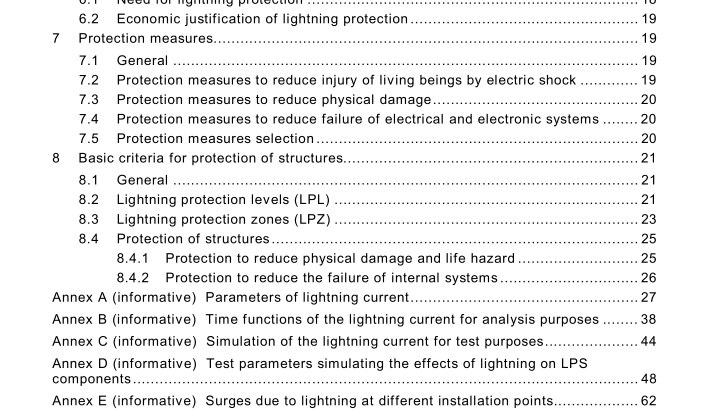IEC 62305-1:2010 pdf download – Protection against lightning – Part 1: General principles
8 Basic criteria for protection of structures 8.1 General An ideal protection for structures would be to enclose the structure to be protected within an earthed and perfectly conducting continuous shield of adequate thickness, and to provide adequate bonding, at the entrance point into the shield, of the lines connected to the structure.
This would prevent the penetration of lightning current and related electromagnetic field into the structure to be protected and prevent dangerous thermal and electrodynamic effects of current, as well as dangerous sparkings and overvoltages for internal systems. In practice, it is often neither possible nor cost effective to go to such measures to provide such full protection. Lack of continuity of the shield and/or its inadequate thickness allows the lightning current to penetrate the shield causing: – physical damage and life hazard; – failure of internal systems. Protection measures, adopted to reduce such damages and relevant consequential loss, shall be designed for the defined set of lightning current parameters against which protection is required (lightning protection level).
8.2 Lightning protection levels (LPL) For the purposes of IEC 62305, four lightning protection levels (I to IV) are introduced. For each LPL, a set of maximum and minimum lightning current parameters is fixed.
NOTE 1 Protection against lightning whose maximum and minimum lightning current parameters exceed those relevant to LPL I needs more efficient measures which should be selected and erected on an individual basis.
NOTE 2 The probability of occurrence of lightning with minimum or maximum current parameters outside the range of values defined for LPL I is less than 2 %. The maximum values of lightning current parameters relevant to LPL I shall not be exceeded, with a probability of 99 %. According to the polarity ratio assumed (see Clause A.2), values taken from positive flashes will have probabilities below 1 0 %, while those from negative flashes will remain below 1 % (see Clause A.3). The maximum values of lightning current parameters relevant to LPL I are reduced to 75 % for LPL II and to 50 % for LPL III and IV (linear for I, Q and di/dt, but quadratic for W/R). The time parameters are unchanged.
NOTE 3 Lightning protection levels whose maximum lightning current parameters are lower than those relevant to LPL IV allow one to consider values of probability of damage higher than those presented in Annex B of IEC 62305-2:201 0, but not quantified and are useful for better tailoring of protection measures in order to avoid unjustified costs.
The maximum values of lightning current parameters for the different lightning protection levels are given in Table 3 and are used to design lightning protection components (e.g. cross-section of conductors, thickness of metal sheets, current capability of SPDs, separation distance against dangerous sparking) and to define test parameters simulating the effects of lightning on such components (see Annex D). The minimum values of lightning current amplitude for the different LPL are used to derive the rolling sphere radius (see Clause A.4) in order to define the lightning protection zone LPZ 0 B which cannot be reached by direct strike (see 8.3 and Figures 3 and 4). The minimum values of lightning current parameters together with the related rolling sphere radius are given in Table 4. They are used for positioning of the air-termination system and to define the lightning protection zone LPZ 0 B (see 8.3).
The protection measures specified in IEC 62305-3 and IEC 62305-4 are effective against lightning whose current parameters are in the range defined by the LPL assumed for design. Therefore the efficiency of a protection measure is assumed equal to the probability with which lightning current parameters are inside such range. For parameters exceeding this range, a residual risk of damage remains.
8.3 Lightning protection zones (LPZ) Protection measures such as LPS, shielding wires, magnetic shields and SPD determine lightning protection zones (LPZ).
